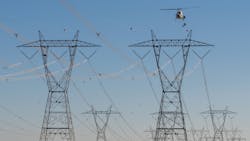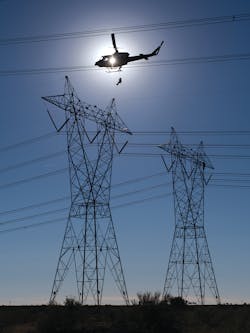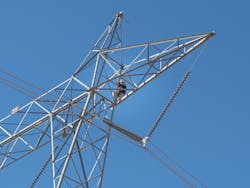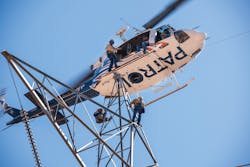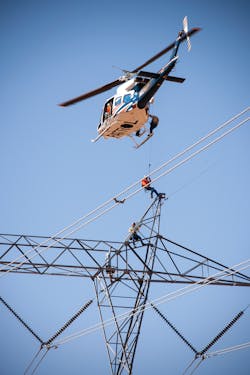The expansive metro area in Phoenix, Arizona, U.S., stretches across a desert valley blasted by heat and sun. Summer temperatures can soar to 110°F (43°C), and more than 1 million Phoenix-area customers rely on Salt River Project (SRP) for electricity to power their air conditioners, laptops and other devices so they can safely work from home during the COVID-19 pandemic. SRP line workers play a critical role in keeping the lights on and reliable power flowing to customers in their time of need.
Transmission maintenance jobs require SRP line workers to travel more than 280 miles (450 km) along the utility’s 500-kV system, spanning from the Coronado generating station in far-east St. Johns, Arizona, down to the Palo Verde generating station in southwestern Tonopah, Arizona. SRP transmission lines and towers are inspected regularly and aerial examinations of the full system conducted at least twice each year.
This work is more efficient and effective when performed by SRP’s team of aerial-certified line workers, trained to drop from SRP’s helicopter onto transmission towers. This team of 12 who travels by air performs maintenance work using the barehand method on energized transmission lines. The line workers inspect anywhere from 60 towers to 70 towers in one day. It is an expedited process compared to climbing up and down towers and driving from job to job—but only when done precisely right. (Imagine how long would it take to inspect 70 towers using a ground patrol!)
A Trapeze of Energized Lines
To learn how to work safely from tall heights, all line workers must invest time in training. SRP’s team of aerial line workers, however, must also become hoist certified. To perform the high-flying work, they are required to complete a minimum of 80 additional hours of training beyond what they would obtain as a traditional line worker.
The opportunity to work on this specialized SRP team is extended to any SRP journeyman line worker willing to take on the challenge. The only caveat is the turnover rate for this crew is low and crew members tend to stay on for many years, which means available spaces are limited.
Once a line worker is given the opportunity to work on the aerial team, they are trained in-house by experienced aerial line workers and receive instruction from SRP’s chief helicopter pilot, who ultimately is responsible for the entire helicopter hoisting program at SRP. The line workers learn the ins and outs of the helicopter’s mechanics as well as the hazards and safety issues pertaining to helicopter operations. They also learn about the hoist operation, which includes following a set of operating procedures for getting on and off the hoist hook and safely landing on a transmission tower. Trainees also run through a set of emergency procedures in the event of an abnormal operation.
Through their specialized training, the aerial line workers learn a carefully choreographed descent from the helicopter’s aerial hoist directly onto energized towers standing 150 ft (46 m) high. A hoist operator assists the line workers with their drop down from the helicopter. Line workers learn to use their hands and feet to control the sway of their body from gusts of wind before landing on and attaching to the tower and then unhooking from the aircraft.
In certain instances, line workers may conduct a repair while working from the hoist cable, just down from the helicopter, without hooking onto a tower. This happens mostly in remote locations for static repair or conductor repair of minor damage from lightening or similar causes.
Line workers in the aerial unit use the barehand method, which enables them to bond to the high-voltage transmission lines. They wear a specialized, stainless-steel Nomex fabric suit that is flame resistant. The line workers fix issues on the transmission lines while electricity flows around their body, which they describe as the sensation of “insects crawling on the surfaces of your skin.” Even with the suit hood over their head, they can hear the electric current from the generating station hundreds of miles away, which demonstrates the sheer power of the voltage with which they are working.
Using the barehand method also quickens the entire maintenance process as line workers can be nimble with their hands and close to their work, not slowed down by using rated hot stick tools that can, at times, create ergonomic distance barriers between the worker and the line.
Safety in the Details
An average day of inspections for these crews is between 10 hours to 14 hours. Long before liftoff, the full crew conducts and participates in a detailed tailboard or pre-job plan. The plan outlines everyone’s role, from the helicopter pilot and hoist operators to the specialized line workers. Everyone knows the exact route and moves each person will make and they come prepared to deal with complications, including emergency action procedures.
At times, the environment can be unpredictable. Unexpected wind gusts can cause the helicopter to move inadvertently, and these shifts in motion can transfer down to the line worker on the hoist. When these unexpected movements occur, communication between the hoist operator and helicopter pilot is pivotal. The hoist operator can abort the insertion operation at any time. The line worker also is equipped with a breakaway device that enables the worker to stay safely attached to the tower while the helicopter is quickly disconnected from the worker.
Spending long lengths of time together, the crew members regard each other as family, with full and complete trust in one another. It does not undermine, and in fact adds to, the absolute level of concentration each individual must have while completing jobs. Their every thought and move must be focused on the task at hand.
Focus is something aerial-certified line workers can never be without. The process of using the helicopter for projects like this saves not only time but also expendable energy. Climbing a tower is tiring, to say the least, and can result in possible injury, including heat exhaustion if line workers are not careful. The long descent down the more than 10-story tower must also be factored in. Dropping down from the aircraft to inspect a full tower requires only a one-way trip down, giving the line worker the luxury of using less energy and having greater focus, thereby creating a safer practice overall.
Efficiency is the Goal
For SRP, using specially trained aerial line workers for transmission inspection work has become essential to the utility’s operations and grid reliability. The process is designed for efficiency, as flight travel cuts the length of maintenance jobs down by hours. The team’s process also is designed to lessen the risk of a 500-kV line being down for any extended length of time. One transmission line down can result in less redundancy and slightly more risk to the transmission system, which is not optimal when Arizona heat is on the rise.
Technical facets of the process include helicopter pilots trained to fly at minimum helicopter approach distances (MHAD), as close and as steady as possible to energized transmission lines. While other utilities and companies in the industry may allow for the energization of a helicopter, SRP does not allow electrical contact between its helicopter and transmission lines. This rule is in place is to maintain another level of safety for the helicopter and crew.
The highly technical process also deals with coming prepared with the proper tools, which must be attached on the line worker or packed into the aircraft ahead of liftoff. The team must be fully prepared for numerous situations while miles away from the utility’s facilities. For example, the line workers pack hot sticks, tower rescue kits, advanced first aid trauma kits and all the necessary personal protective equipment (PPE) to work safely.
The line workers conduct thorough inspections while on a tower. The team takes the time to climb the full surface, searching for all potential complications that could result in reduced reliability. They look for anything from rust and standard wear and tear to loose bolts and broken hardware. The thorough nature of the inspection operation is completely intentional to enhance reliability and efficiency over time. SRP’s policy is to inspect each transmission tower at least once every seven years, and crews will never go longer than that without completing a hands-on inspection.
As a not-for-profit public utility, SRP ensures reliable power for residents living in the Phoenix area through the hard work and determination of its essential service workers. With nearly 20,000 structures in its transmission system and more than 2000 line miles (3219 line km) of transmission conductors, SRP is committed to continued operational excellence and providing safe, reliable, and affordable power for years to come. SRP’s aerial-certified line workers remain a critical facet of its overall operations and system.
Jace Kerby is manager of transmission line maintenance at Salt River Project (SRP), where he is responsible for all repair and maintenance issues on the utility’s transmission line system. He has served with the utility since 1999, having started his career as a treaded helper and progressing to apprentice lineman, journeyman, foreman and now manager. Kerby earned his bachelor’s degree in business administration from Walden University.
About the Author
Jace Kerby
Jace Kerby ([email protected]) is manager of transmission line maintenance at Salt River Project (SRP), where he is responsible for all repair and maintenance issues on the utility’s transmission line system. He has served with the utility since 1999, having started his career as a treaded helper and progressing to apprentice lineman, journeyman, foreman and now manager. Kerby earned his bachelor’s degree in business administration from Walden University.
